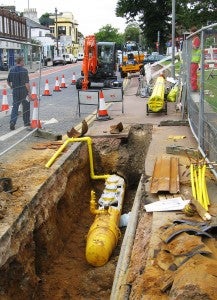By Virginia Palacios and Holly Pearen

Plastic pipeline being placed in a trench.
The tragic 2010 San Bruno pipeline explosion served as proof of how a small pipeline leak combined with human error can cause a devastating disaster. This has led the Pipeline and Hazardous Materials Safety Administration (PHMSA) to propose new regulations for gas pipelines across the country in order to prevent another major pipeline catastrophe.
At the same time, utilities are beginning to adopt advanced technologies and methods that provide better data to experts — helping to prevent accidents that threaten public health and safety. If PHMSA requires operators to use these emerging leak detection technologies and quantification and analytical methods, we could see improved utility safety programs and a decline in incidents related to human error.
Qualitative intelligence + Quantitative data
A new study by PricewaterhouseCoopers (PwC) finds that readily available technologies can enhance the information available at pipeline operators’ fingertips and reduce the opportunity for human error by using existing data on failure histories, customer calls, and condition-assessments to manage their pipeline system with more transparency. This, in turn, takes out some of the guess work that experts might use to make subjective recommendations about pipeline safety.
Operators can also integrate spatial analytics with information about the pipeline’s condition to get a scientifically rigorous snapshot of pipeline risks in near real-time to inform investment planning and better prioritize where pipeline replacement projects take place. The PwC report also says data from advanced leak detection technology can be added to traditional utility data sets and analyzed to provide new information on the frequency of leaks in a given area. In fact, some operators like PG&E and CenterPoint Energy are integrating advanced leak detection and quantification data into predictive models that can help pipeline operators proactively repair or replace risky pipeline segments before they become a problem.
Altogether, the PwC study concludes that spatially-attributed data from advanced leak detection technology can offer calculable data to improve risk assessment. The methods can help experts find more gas leaks faster, improve pipeline integrity and reduce risks to public health and safety.
Improving pipeline safety nationwide
Some utilities have already started implementing spatial analytics, advanced leak detection, and leak quantification methods for infrastructure management to improve the safety and integrity of the gas systems – which should be the standard nationwide.
PHMSA has deferred rulemaking on leak detection to a subsequent, as yet unscheduled process. But there are several places in the current proposed gas pipeline safety rules where the agency could incorporate leading leak detection and quantification practices:
- Threat identification, including consideration of leak and failure history
- Use of “objective, traceable, verifiable and validated information and data” that helps to reduce bias and human error in decision making
- Additional measures that must be taken to prevent pipeline failure or reduce consequences of failure in areas that would not normally be a high priority
- Surveying for leaks with methane analyzers for low-pressure pipelines
PHMSA’s proposed rules are long overdue, and if adopted intact would greatly improve pipeline safety. However, the rules could reduce risks even further if they included references and requirements to use spatially-attributed, advanced leak detection and quantification data.
While engineers and on-the-ground professional analysis will always be important for protecting pipelines, current technologies can provide a useful backstop to support decisions that can have serious consequences.
Image source: Andrew Dunn, Wikimedia









